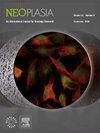CaP CURE:前列腺癌治疗协会。
IF 7.7
2区 医学
Q1 ONCOLOGY
引用次数: 1
摘要
前列腺癌是男性癌症死亡的第二大原因。2002年,估计有18.9万名男子被诊断患有前列腺癌,近3万名男子将死于这种疾病。前列腺癌的早期症状很少,如果有的话。然而,前列腺癌是男性中最常见的非皮肤癌,一生中每六个人中就有一个受其影响。随着7600万婴儿潮一代的年龄继续增长,更多的男性将面临这种风险。本文章由计算机程序翻译,如有差异,请以英文原文为准。
CaP CURE: Association for the Cure of Cancer of the Prostate.
Prostate Cancer Prostate cancer is the second leading cause of cancer death in men. In 2002, an estimated 189,000 men will be diagnosed with prostate cancer and almost 30,000 men will lose their lives to the disease. Prostate cancer frequently causes few, if any, symptoms in its early stages. Yet, prostate cancer is the most commonly occurring non–skin cancer in men, affecting one man in every six during his lifetime. More men will be at risk as the 76 million members of the baby boom generation continue to age.
求助全文
通过发布文献求助,成功后即可免费获取论文全文。
去求助
来源期刊

Neoplasia
ONCOLOGY-
自引率
2.10%
发文量
82
期刊介绍:
Neoplasia publishes the results of novel investigations in all areas of oncology research. The title Neoplasia was chosen to convey the journal’s breadth, which encompasses the traditional disciplines of cancer research as well as emerging fields and interdisciplinary investigations. Neoplasia is interested in studies describing new molecular and genetic findings relating to the neoplastic phenotype and in laboratory and clinical studies demonstrating creative applications of advances in the basic sciences to risk assessment, prognostic indications, detection, diagnosis, and treatment. In addition to regular Research Reports, Neoplasia also publishes Reviews and Meeting Reports. Neoplasia is committed to ensuring a thorough, fair, and rapid review and publication schedule to further its mission of serving both the scientific and clinical communities by disseminating important data and ideas in cancer research.
 求助内容:
求助内容: 应助结果提醒方式:
应助结果提醒方式:


